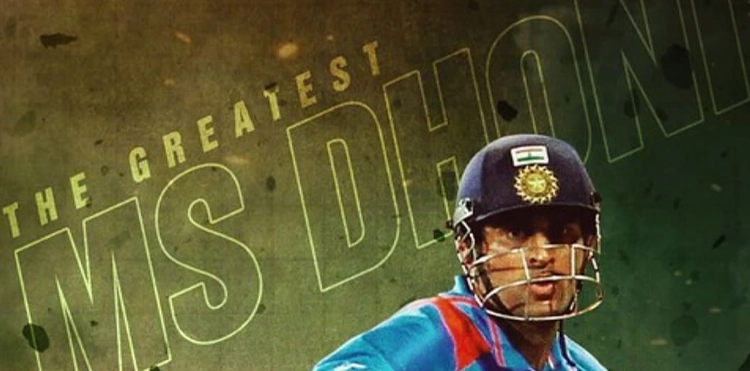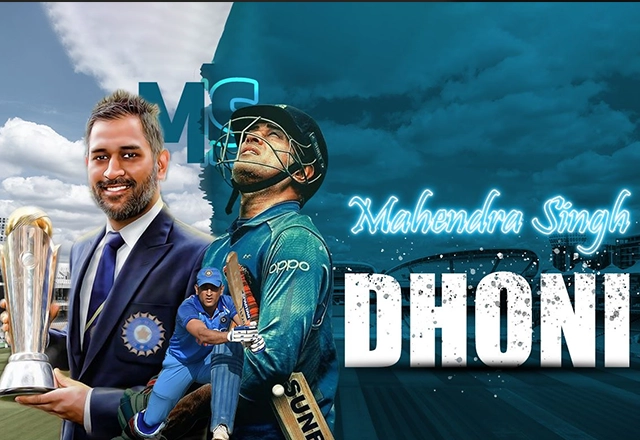Personal Information
| Name | Mahendra Singh Dhoni (MS Dhoni) |
| Born | Jul 07, 1981 (41 years) |
| Birth Place | Ranchi, Bihar (now Jharkhand) |
| Height | 5 ft 11 in (180 cm) |
| Role | WK-Batsman |
| Batting Style | Right-Handed Bat |
| Bowling Style | Right-Arm Medium |
ICC Ranking
| Role | Test | ODI | T20 |
| Batting | – | – | – |
| Bowling | – | – | – |

Career Information
| Teams | India, Asia XI, Chennai Super Kings, Indians, Jharkhand, Rising Pune Supergiant, India A |
Batting Career Summary
| M | INN | NO | Runs | HS | Avg | BF | SR | 100 | 200 | 50 | 4s | 6s | |
| Test | 90 | 144 | 16 | 4876 | 224 | 38.09 | 8248 | 59.12 | 6 | 1 | 33 | 544 | 78 |
| ODI | 350 | 297 | 84 | 10773 | 183 | 50.58 | 12303 | 87.56 | 10 | 0 | 73 | 826 | 229 |
| T20I | 98 | 85 | 42 | 1617 | 56 | 37.6 | 1282 | 126.13 | 0 | 0 | 2 | 116 | 52 |
| IPL | 241 | 211 | 83 | 5039 | 84 | 39.37 | 3713 | 135.71 | 0 | 0 | 24 | 348 | 235 |
Bowling Career Summary
| M | INN | B | Runs | Wkts | BBI | BBM | Econ | Avg | SR | 5W | 10W | |
| Test | 90 | 7 | 96 | 67 | 0 | 0/1 | 0/1 | 4.19 | 0 | 0 | 0 | 0 |
| ODI | 350 | 2 | 36 | 31 | 1 | 1/14 | 1/14 | 5.17 | 31.0 | 36.0 | 0 | 0 |
| T20I | 98 | – | – | – | – | – | – | – | – | – | – | – |
| IPL | 241 | – | – | – | – | – | – | – | – | – | – | – |
Career Information
| Test Debut | vs Sri Lanka at MA Chidambaram Stadium, Dec 02, 2005 |
| Last test | vs Australia at Melbourne Cricket Ground, Dec 26, 2014 |
| ODI debut | vs Bangladesh at MA Aziz Stadium, Dec 23, 2004 |
| Last ODI | vs New Zealand at Emirates Old Trafford, Jul 09, 2019 |
| T20 debut | vs South Africa at The Wanderers Stadium, Dec 01, 2006 |
| Last T20 | vs Australia at M.Chinnaswamy Stadium, Feb 27, 2019 |
| IPL debut | vs Punjab Kings at Punjab Cricket Association IS Bindra Stadium, Apr 19, 2008 |
| Last IPL | vs Kolkata Knight Riders at Eden Gardens, Apr 23, 2023 |
Biography – About Mahendra Singh Dhoni
Apart from Sachin Tendulkar and Virat Kohli, Mahendra Singh Dhoni is arguably the most popular and closely scrutinised cricketer in India. Despite hailing from the cricketing backwaters of the mining state of Jharkhand, he has made a name for himself through his unique batting and wicket keeping technique, as well as his captaincy style that blends both conservatism and unorthodoxy. Under Mahendra Singh Dhoni’s leadership, India has achieved the top prize in all formats, including topping the Test rankings for 18 months starting December 2009, winning the 50-over World Cup in 2011, and clinching the World T20 on his captaincy debut in 2007.
Before he was 23, Mahendra Singh Dhoni worked as a ticket inspector for the Indian Railways and was relatively unknown except for a few whispers among club cricket followers in Kolkata. However, he caught the attention of many after he scored two centuries in a triangular 50-over tournament for India A in Nairobi. With his long hair and fearless attitude, he quickly made his way into international cricket and became an instant crowd favourite after scoring 148 and 183 in ODI innings within a year of his debut.
Mahindra Singh Dhoni exemplified the best qualities of the emerging middle-class in India. He showed respect for everyone, regardless of their reputation, without ever being disrespectful. He was adaptable and always learning, but never felt the need to apologise for his unique batting style, which some might not consider elegant. He developed into a versatile ODI batsman, capable of accumulating runs, rebuilding innings, and hitting big sixes when needed.
During his career, Mahendra Singh Dhoni demonstrated strong leadership abilities, which were acknowledged when Rahul Dravid stepped down as captain in 2007. Prior to Dravid’s announcement, Dhoni had already led a group of young players to South Africa and was instrumental in India’s victory in a format that was not previously taken seriously by the country. It was a natural progression for him to take on the ODI captaincy, and Anil Kumble temporarily filled the role in Tests for a year.
As captain, Dhoni possessed a resilient attitude and a certain level of detachment from results, which is necessary for an Indian captain to maintain their position for an extended period. Working alongside coach Gary Kirsten, he created a comfortable environment for his senior players, who in turn delivered some of their best performances in international cricket.
Dhoni’s composed demeanour was particularly effective in shorter formats, although he occasionally waited too long to make tactical decisions in Tests. Nevertheless, it is undeniable that India experienced some of their most successful years in Test cricket under Dhoni’s leadership.
Following India’s 50-over World Cup victory in 2011, Dhoni secured the win with a well-timed 91 and his signature helicopter shot. However, the team began to struggle in unfamiliar conditions due to their ageing roster.
After eight consecutive Test losses away from home, Dhoni faced immense pressure as captain. This was further compounded by a 2-1 home series loss to England in 2012-13, marking India’s first home loss in over eight years. This period marked a turning point in Dhoni’s career, as he became more assertive as a captain, built a new team, played his best Test innings on a turner to win India the Chennai Test against Australia, and became the first captain to lead India to four wins in a series.
During the winter of 2013-14, India lost Test series in South Africa and New Zealand by narrow 1-0 margins, despite coming close to wins on both tours. The England tour of 2014 started off well, with a drawn first Test followed by a historic victory at Lord’s. However, India’s fortunes quickly turned as they lost the series 3-1. Despite the batting lineup struggling around him, Dhoni played two of his most courageous innings in Tests at Old Trafford and The Oval. He faced the challenging seam movement and bounce by stepping down the pitch and taking blows on his body.
Despite their fierce competitiveness, India was unable to secure any wins during their tour of Australia that followed. However, the team’s young batting core, led by Kohli, put up a strong fight.
In the absence of Mahendra Singh Dhoni, Kohli had taken over the captaincy in the first Test and continued to lead the team in the fourth Test as well. However, after the third Test in Melbourne, Dhoni made a surprising announcement that he was retiring from the longest format.
Despite his game being more suitable for limited-overs cricket, Mahendra Singh Dhoni concluded his Test career with an impressive record as a wicketkeeper, scoring 4876 runs at an average of slightly over 38, including six centuries. Additionally, he holds the record for captaining India to the most Test wins, with a total of 27 victories.
Following a win-less tour of Australia, Mahendra Singh Dhoni continued to lead India in the shorter formats, leading them to the semi-finals of the 2015 World Cup. The team also won the Asia Cup T20 in Bangladesh a year later, but were eliminated in the semi-finals of the World T20, which was held in India. Dhoni played a crucial role as a finisher, scoring 89 runs in five innings while being dismissed only once. He also displayed exceptional reflexes while keeping to the spinners. Mahendra Singh Dhoni (MS Dhoni) continued to play until the 2019 World Cup, but relinquished the limited-overs captaincy in January 2017.
Mahendra Singh Dhoni’s final international match was during India’s defeat to New Zealand in the semi-final of the 2019 World Cup. However, it wasn’t officially confirmed until over a year later. After the match, there was a lot of speculation about whether Mahendra Singh Dhoni would retire, but he didn’t. Instead, he opted out of India’s series for the rest of 2019 and early 2020. Due to the Covid-19 pandemic, all sporting events were halted, including the IPL. In August, on India’s Independence Day, just as players were preparing for the delayed IPL, Dhoni made a big announcement on Instagram. He was retiring from all international cricket.
Mahendra Singh Dhoni has been the face of the Chennai Super Kings franchise in the IPL. He was so closely associated with the city that he even became a co-owner of a Chennai-based football franchise. However, in 2016, the Super Kings were suspended for two seasons due to issues related to the spot-fixing scandal of 2013. During this time, Mahendra Singh Dhoni played for the IPL’s new franchise, Rising Pune Supergiants. The Super Kings were reinstated in 2018, and Mahendra Singh Dhoni returned as the team’s captain, leading them to their third title. In 2019, he almost repeated this feat, but the team lost a thrilling final against the Mumbai Indians by just one run.
Get IPL 2023 Live Score along with Points Table & Schedule Updates at IceCric.News and Follow for Live Updates – Twitter, Facebook & Instagram.




